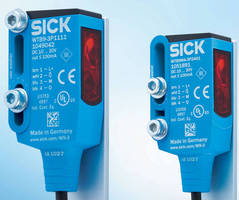Photoelectric Sensor comes in tough plastic housing.
Press Release Summary:

Supplied in VISTAL(TM) housing, W9-3 has over-molded connector and custom ASIC that incorporates OES3 technology, which optimizes background suppression at extended range. Teach-in or potentiometer adjustment is available, and complementary (light and dark operate) outputs are standard. Exhibiting immunity to ambient light, sensor is capable of ignoring stray background reflections and detecting multicolored/shiny objects. Several mounting options are available.
Original Press Release:
SICK's Launches High-performance Photoelectric Sensor in an Extremely Tough Plastic Housing
W9-3 offers best-in-class performance for a range of detection applications
Minneapolis, Minn. - SICK (www.sickusa.com), one of the world's leading manufacturers of sensors, safety systems, machine vision, and automatic identification solutions for factory and logistics automation, today announced the launch of its W9-3 photoelectric sensor, a high-performance sensor in an extremely tough plastic housing. This third-generation sensor has a wide variety of options to choose from, such as sensing range, mounting, and connectivity, making it ideal for many applications. Examples include detecting clear material, multicolored and shiny objects in the material handling and food and beverage industries.
The W9-3 uses a proprietary type of plastic and molding process that makes the sensor as tough as nails. The material, called VISTAL(TM), is 9 x stronger than standard ABS. The sensor's connector is over-molded onto the device creating a sensor that is nearly unbreakable. The W9-3 uses SICK's third generation custom ASIC (application-specific integrated circuit) that incorporates OES3 technology to provide additional advantages, such as exceptional background suppression at an extended range. The OES3 contains proprietary technology that enables the W9-3 to ignore stray background reflections, detect multicolored/shiny objects, and provide high immunity to ambient light.
The W9-3 has many different mounting options due to its slotted through hole design. This feature offers the ability to mount the sensor from 5.2 mm to 13.7 mm and 18.9 mm to 27.4 mm - ensuring the sensor can be mounted in any number of configurations.
Additional Features:
Complementary output:
The W9-3 has complementary (light and dark operate) outputs in one housing. This universal feature helps reduce inventory of different parts that customers typically have in stock to solve multiple types of applications.
Teach-in or potentiometer adjustment:
The W9-3 offers multiple ways to easily adjust the sensing range. Because of OES3 technology, the sensor is electronically taught (no mechanical moving parts). This allows push-button teach-in that is as precise as a potentiometer adjustment.
About SICK
SICK is one of the world's leading manufacturers of sensors, safety systems, machine vision and automatic identification products for industrial applications. With nearly 450 patents, SICK continues to lead the industry in new product innovations. The diversity of its product line allows SICK to offer solutions at every phase of production in the logistics, automotive, packaging, electronics, food and beverage, and material handling markets. SICK was founded in 1946 and has operations or representation in 65 countries worldwide.




